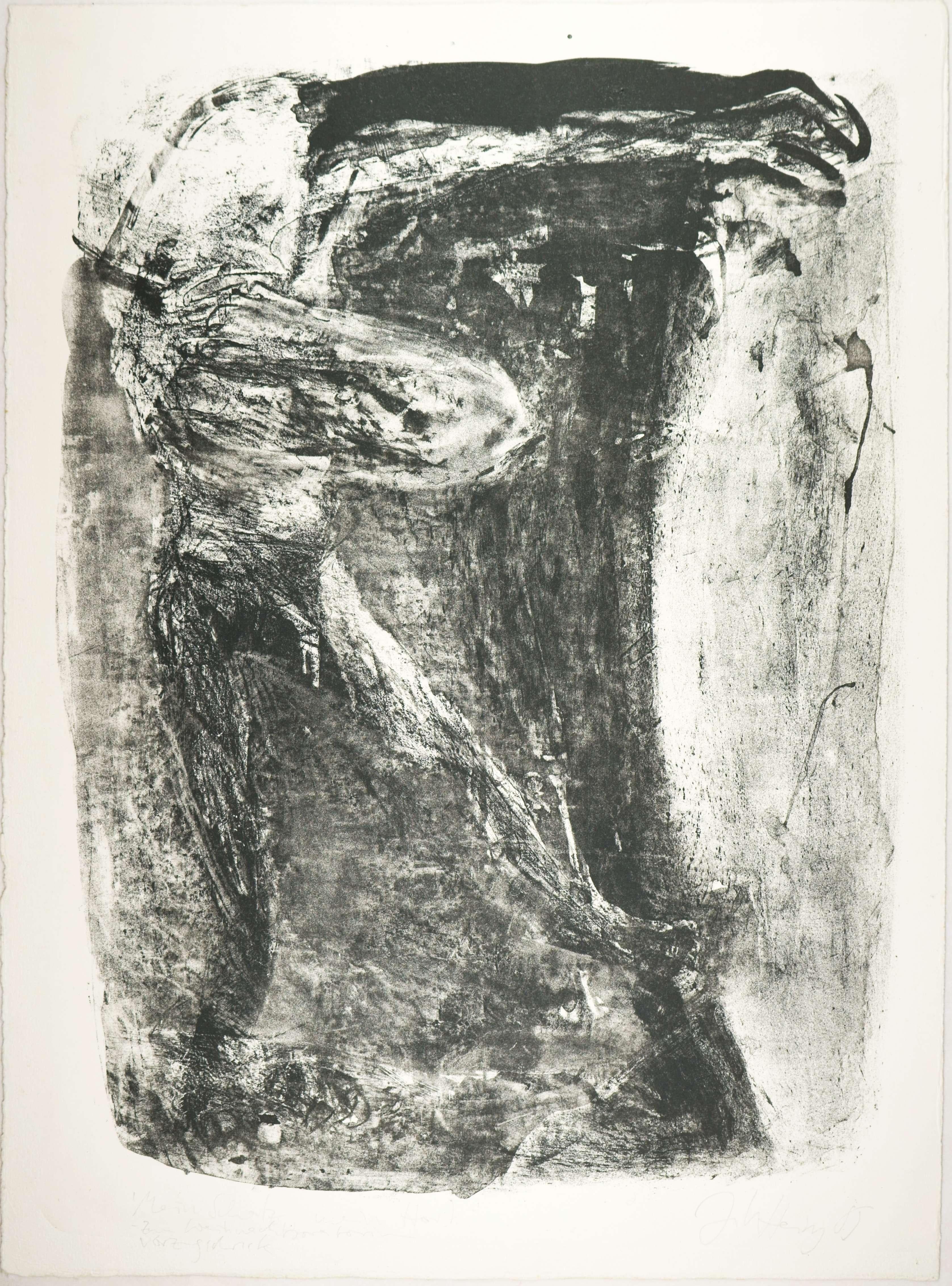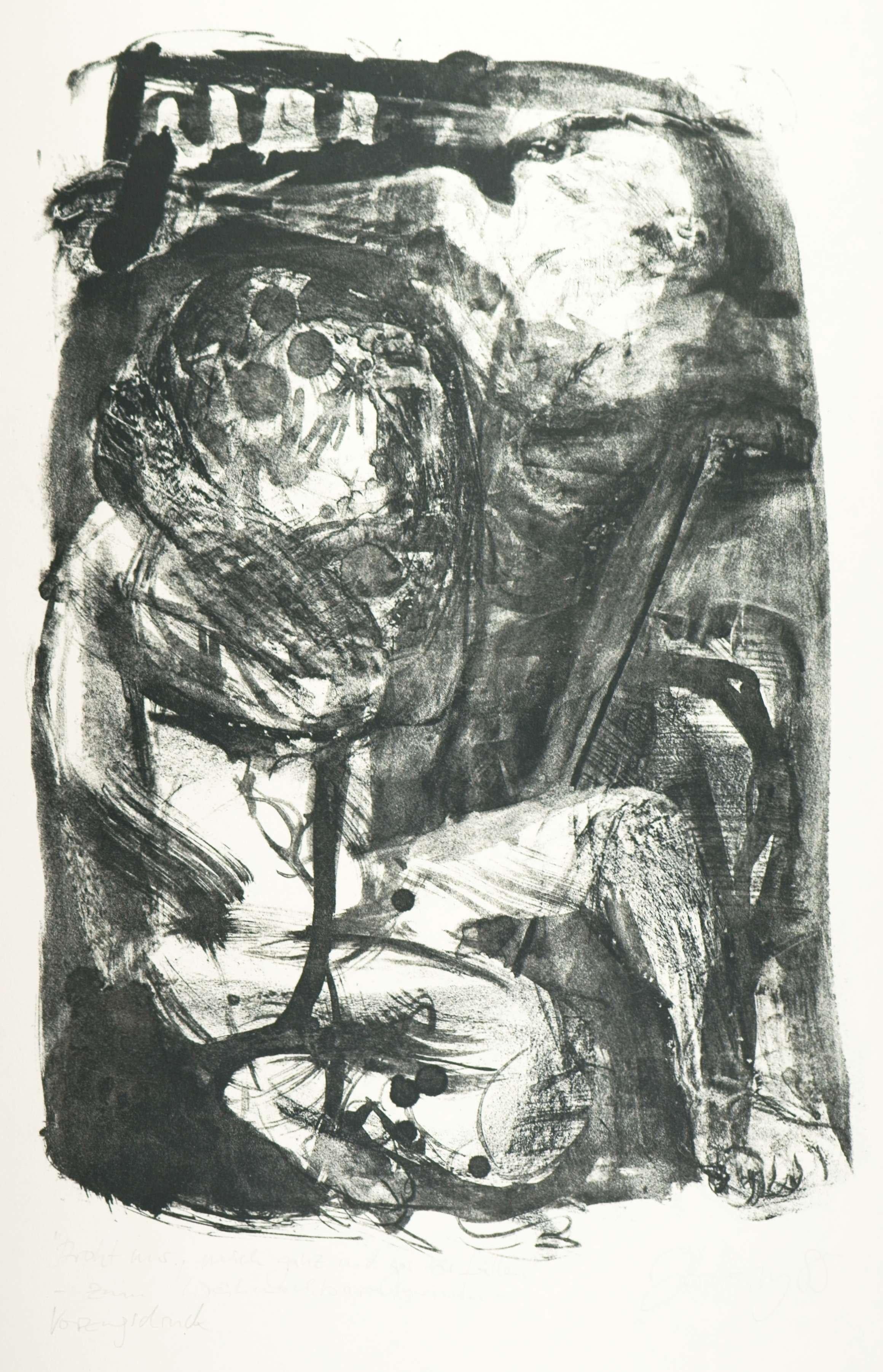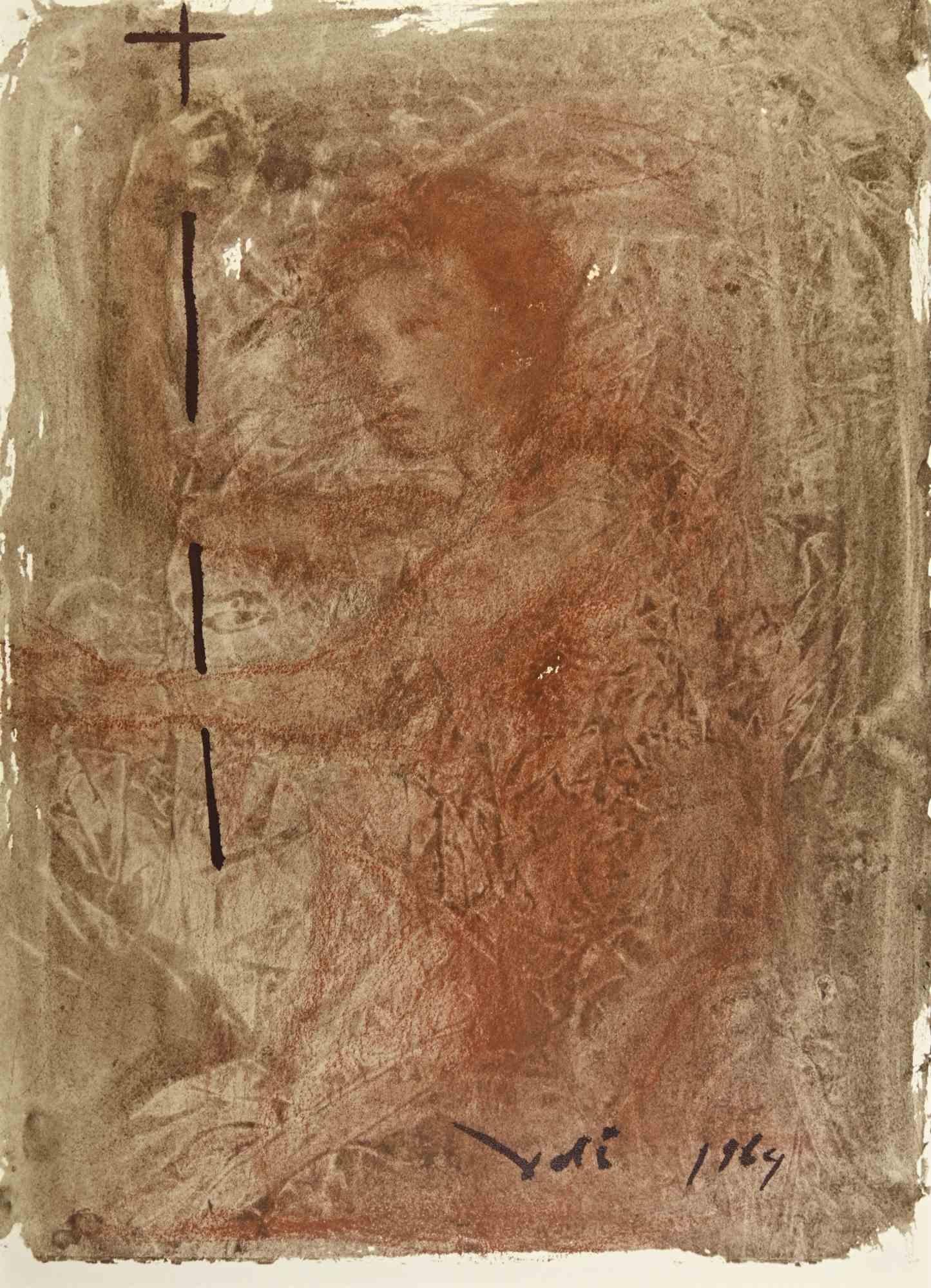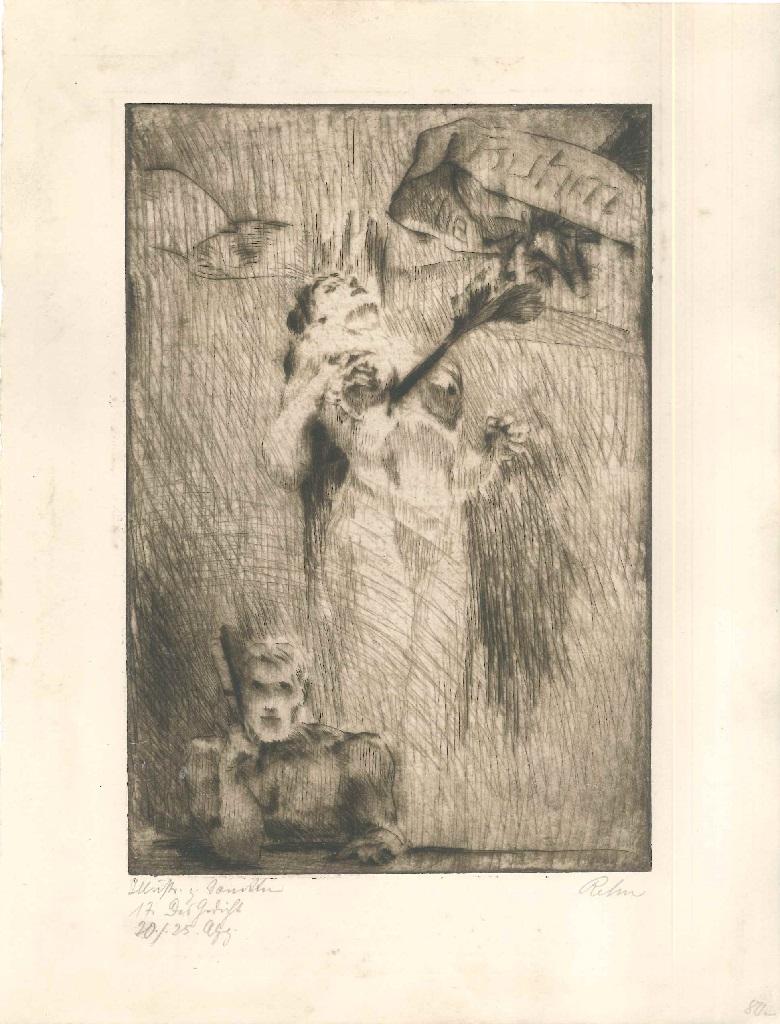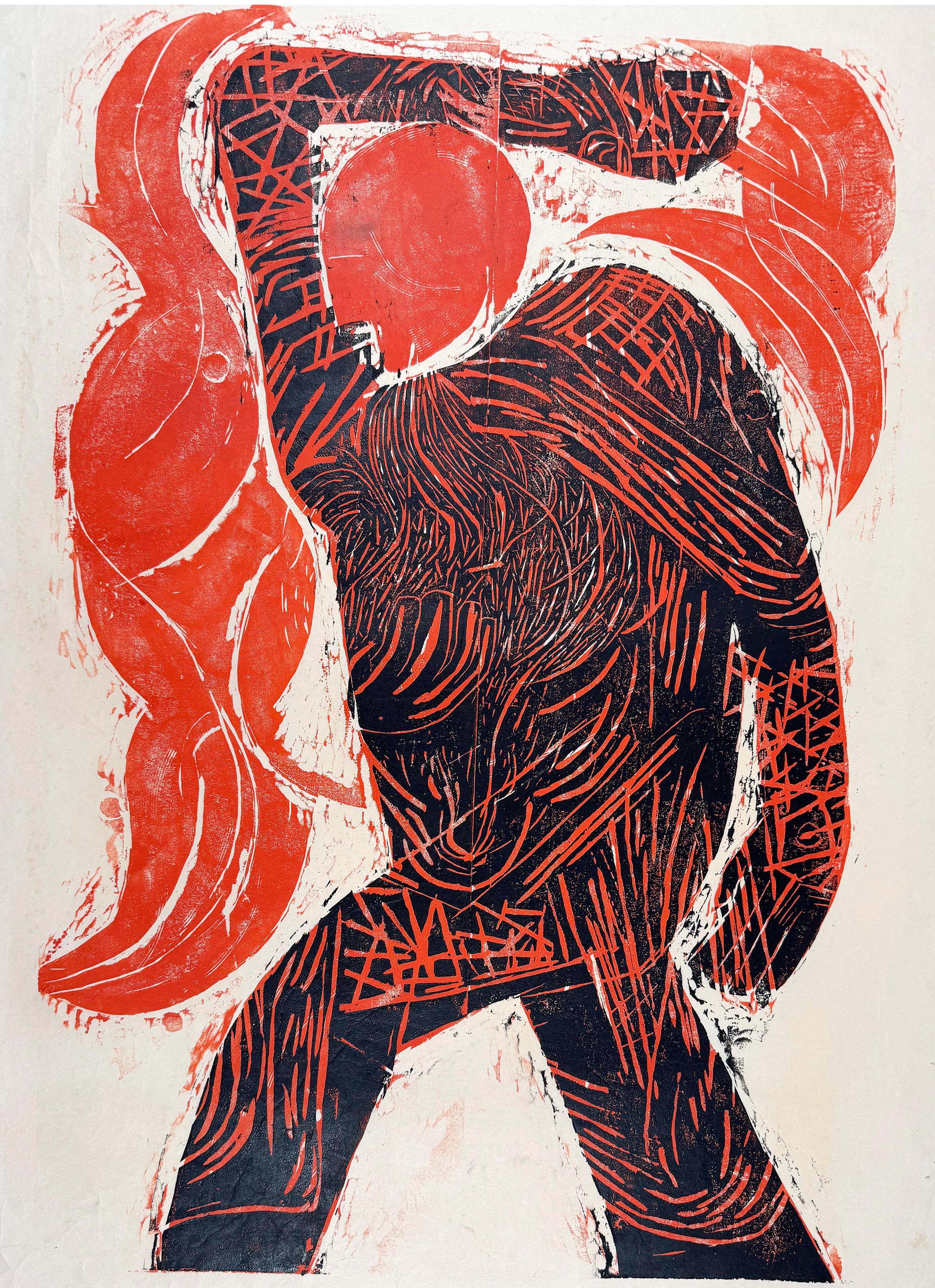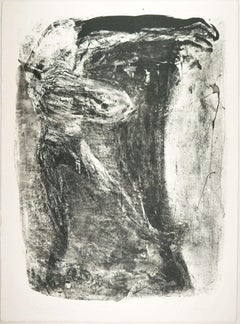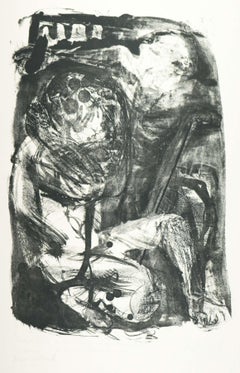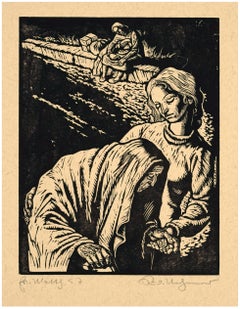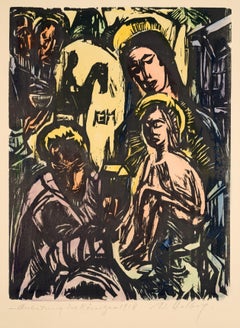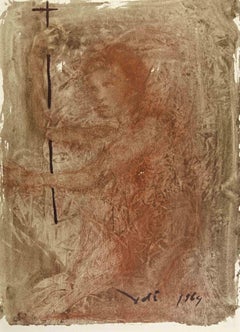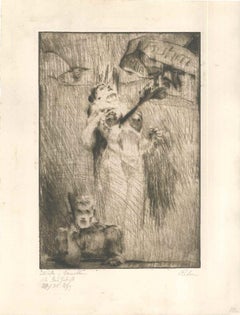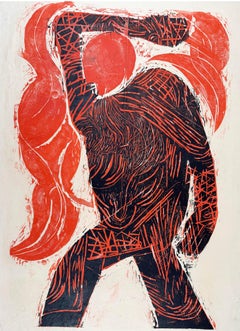Items Similar to The Prophet / - The Burden of the Prophet -
Want more images or videos?
Request additional images or videos from the seller
1 of 7
Wilhelm GrossThe Prophet / - The Burden of the Prophet -c. 1955
c. 1955
$531.16
£404.53
€450
CA$744.56
A$814.57
CHF 425.44
MX$9,734.34
NOK 5,345.02
SEK 5,030.51
DKK 3,427.74
About the Item
Wilhelm Gross (1883 Schlawe - 1974 Oranienburg-Eden), The Prophet, c. 1955. Woodcut on thin laid paper, 43 cm x 23 cm (depiction), 61 cm x 43 cm (sheet size), signed “Dr. Wilh.[elm] Gross” in pencil lower right, inscribed “Orig.[inal] Holzschnitt (Handabdruck)” lower left and inscribed “Aus der ”Ecce homo“ Folge” in the center.
- The wide margin with traces of pressing due to the impression, the sitter's left foot with a small purple stain, otherwise in vibrant condition.
- The Burden of the Prophet -
The large-format woodcut shows a prophet figure that takes up almost the entire height of the sheet. However, instead of seeing something in the distance that is still hidden from our eyes - as is usual in depictions of prophets - the figure has raised his hands in a defensive gesture, as if the prophet is trying to ward off what he has seen. At the same time, however, the position of the arms is an acceptance of the inevitable, which only those who recognize what is to come will have to bear for the time being, which is why the figure in the painting - despite its size - appears almost solitary, alone and exposed to the burden of suffering.
In a manner reminiscent of the folds of medieval wooden sculptures, the expressive figure is "twitched" in a flash, illustrating the drama of the almost superhuman effort. The visible wooden structures of the background develop a vibrato that further energizes the depiction.
Wilhelm Groß left the surface of the wood unpolished when he made the block, using the technique of frottage. The woodcut was printed by hand, so that the grain was rubbed through the paper. For Groß, the grown wood structure is an analogy for individuality, each broken in its own way.
The prophet is a leitmotif in the work of Wilhelm Groß, for whom art itself has a prophetic character: "A beautiful work is [...] a work that appears with prophetic power.
About the artist
After deciding to abandon his career as a civil servant in favor of art, Wilhelm Groß went to Berlin in 1902, where he studied with the sculptors Otto Lessing and August Gaul. After beginning his studies at the Karlsruhe Art Academy, which he had to abandon for financial reasons, Groß returned to Berlin and worked as a freelance artist thanks to the support of his patron Eduard Arnhold. From 1904 until World War II, he enjoyed a fruitful artistic friendship with Max Beckmann. As a member of the Deutscher Künstlerbund (DKB), he won the Villa Romana Prize in 1908, which enabled him to stay in Florence, where he came into contact with Ernst Barlach and Max Klinger. The artist lived in Rome from 1909 to 1911. Called up for World War I, Groß was released from military service in 1915 for health reasons. His experiences in the war, though harrowing, were tantamount to a conversion, and from then on his art was inspired by his faith. His self-built studio in Oranienburg-Eden became a cultural meeting place and, as the "Strohkirche," a meeting place of the Confessing Church during the Nazi era, where Kurt Scharf and Martin Niemöller held services.
In 1933, Groß was classified as "half Jewish," which resulted in a ban on exhibitions, expulsion from the Reich Chamber of Culture, and defamation of his works as "degenerate art. After the end of the Reign of Terror, Groß was ordained as a preacher in the province of Brandenburg and became pastor of the Sachsenhausen congregation. In 1953, he received an honorary doctorate from the Heidelberg Faculty of Theology. The artist responded to Walter Ulbricht's proclamation of the "Ten Commandments of Socialist Morals and Ethics" in 1961 with his last monumental sculpture, which depicts Moses with the Tablets of the Law.
"We should serve the great sculptor God as skilled tools. While working on a cross-bearing Christ in hard oak, I broke half of a valuable tool. Sadly, I put the stump aside and paid no attention to it for years, until one day I picked it up, removed the damaged piece of steel, and had the stump resharpened. Lo and behold, that short, unsightly iron became one of my favorite tools. The Lord works only with broken tools.”
- Wilhelm Gross
GERMAN VERSION
Wilhelm Gross (1883 Schlawe - 1974 Oranienburg-Eden), Der Prophet, um 1955. Holzschnitt auf dünnem Büttenpapier, 43 cm x 23 cm (Darstellung), 61 cm x 43 cm (Blattgröße), unten rechts in Blei mit „Dr. Wilh.[elm] Groß“ signiert, unten links als „Orig.[inal] Holzschnitt (Handabdruck)“ ausgewiesen und mittig mit „Aus der „Ecce homo“ Folge“ bezeichnet.
- Der breite Rand mit abdruckbedingten Pressspuren, der linke Fuß des Dargestellten mit kleiner lila Einfärbung, ansonsten in farbkräftigem Zustand.
- Die Last des Propheten -
Der großformatige Holzschnitt zeigt eine Prophetengestalt, die nahezu die gesamte Höhe des Blattes durchmisst. Anstatt jedoch – wie für Prophetendarstellung üblich – etwas in der Ferne zu erschauen, was unseren Augen noch verborgen bleibt, hat die Gestalt die Hände in einem Abwehrgestus erhoben, als ob der Prophet danach trachtete, das Erschaute abzuwehren. Die Armhaltung ist aber zugleich eine Annahme des Unumgänglichen, das zunächst einzig derjenige zu tragen hat, der das Kommende gewahrt, weshalb die Figur im Bild – trotz ihrer Größe – geradewegs einsam wirkt und allein der Last des Leidens ausgesetzt ist.
In einer die Gewandfalten mittelalterlicher Holzskulpturen aufgreifenden Weise wird die expressive Gestalt blitzartig ‚durchzuckt‘, was die Dramatik der schier übermenschlichen Kraftanstrengung veranschaulicht. Die sichtbaren Holzstrukturen des Hintergrundes entfalten ein Vibrato, das die Darstellung zusätzlich energetisiert.
Wilhelm Groß hat bei der Anfertigung des Druckstocks die Holzoberfläche ungeschliffen belassen und auf diese Weise das Mittel der Frottage eingesetzt. Der Holzschnitt ist im Handdruckverfahren entstanden, so dass die Holzmaserung auf das Papier durchgerieben wird. Für Groß ist die gewachsenen Holzstruktur eine Analogie für die je auf ihre Weise in sich gebrochene Individualität.
Der Prophet ist ein Leitmotiv im Werk von Wilhelm Groß, für den die Kunst selbst durch einen prophetischen Charakter gekennzeichnet ist: „Ein schönes Werk ist […] ein Werk, das in prophetischer Kraft auftritt“.
zum Künstler
Nach der Entscheidung die eingeschlagene Beamtenlaufbahn zugunsten der Kunst aufzugeben, ging Wilhelm Groß 1902 nach Berlin und lernte dort bei den Bildhauern Otto Lessing und August Gaul. Nach der Aufnahme des Studiums an der Kunstakademie Karlsruhe, dass er aus finanziellen Gründen abbrechen musste, kehrte Groß nach Berlin zurück und war dank der Unterstützung des Mäzens Eduard Arnhold als freischaffender Künstler tätig. Von 1904 bis zum Zweiten Weltkrieg verband in eine künstlerisch fruchtbare Freundschaft mit Max Beckmann. Als Mitglied des Deutschen Künstlerbunds (DKB) gewann er 1908 den Villa-Romana-Preis, der ihm einen Aufenthalt in Florenz ermöglichte, wo er in Kontakt mit Ernst Barlach und Max Klinger kam. Von 1909 bis 1911 lebte der Künstler in Rom. Zum Ersten Weltkrieg einberufen, wurde Groß 1915 aus gesundheitlichen Gründen vom Militärdienst freigestellt. Die dennoch einschneidenden Kriegserfahrungen kamen einem Bekehrungserlebnis gleich, so dass seine Kunst fortan vom Glauben getragen war. Sein in Oranienburg-Eden selbstgebautes Atelier entwickelte sich zum kulturellen Treffpunkt und war als „Strohkirche“ während der NS-Zeit Versammlungsort der Bekennenden Kirche, in der Kurt Scharf und Martin Niemöller Gottesdienste abhielten.
1933 war Groß als „Halbjude“ eingestuft worden, was mit einem Ausstellungsverbot, dem Ausschluss aus der Reichskulturkammer und der Diffamierung seiner Werke als „entartete Kunst“ einherging. Nach dem Ende der Schreckensherrschaft wurde Groß zum Prediger der Provinz Brandenburg ordiniert und Pastor der Gemeinde Sachsenhausen. 1953 verlieh ihm die Theologische Fakultät Heidelberg die Ehrendoktorwürde. Die Verkündung der „Zehn Gebote der sozialistischen Moral und Ethik“ durch Walter Ulbricht im Jahr 1961 beantwortete der Künstler mit seiner letzten monumentalen Plastik, die Mose mit den Gesetzestafeln darstellt.
„Wir sollen ja dem großen Bildhauer Gott als geschickte Werkzeuge dienen. Beim Arbeiten an einem kreuztragenden Christus in hartem Eichenholz brach mir ein wertvolles Werkzeug zur Hälfte ab. Traurig tat ich den Stumpf beiseite und habe ihn jahrelang nicht beachtet, bis ich ihn eines Tages wieder zur Hand nahm, das beschädigte Stück Stahl entfernen und den Stumpf wieder neu anschleifen ließ. Und siehe da, dies kurze, unansehnliche Eisen ist eines meiner Lieblingswerkzeuge geworden. Gott der Herr arbeitet nur mit zerbrochenen Werkzeugen.“
Wilhelm Groß

About the Seller
5.0
Vetted Professional Seller
Every seller passes strict standards for authenticity and reliability
Established in 2014
1stDibs seller since 2023
22 sales on 1stDibs
- ShippingRetrieving quote...Shipping from: Berlin, Germany
- Return Policy
Authenticity Guarantee
In the unlikely event there’s an issue with an item’s authenticity, contact us within 1 year for a full refund. DetailsMoney-Back Guarantee
If your item is not as described, is damaged in transit, or does not arrive, contact us within 7 days for a full refund. Details24-Hour Cancellation
You have a 24-hour grace period in which to reconsider your purchase, with no questions asked.Vetted Professional Sellers
Our world-class sellers must adhere to strict standards for service and quality, maintaining the integrity of our listings.Price-Match Guarantee
If you find that a seller listed the same item for a lower price elsewhere, we’ll match it.Trusted Global Delivery
Our best-in-class carrier network provides specialized shipping options worldwide, including custom delivery.More From This Seller
View AllMy treasure, my sanctuary / - A Tortured Treasure -
Located in Berlin, DE
Johannes Heisig (*1953 Leipzig), "My treasure, my sanctuary" - To the Christmas Oratorio by Johann Sebastian Bach. Lithograph on strong yellowish laid paper with watermark, 53 x 39.5...
Category
1980s Abstract Expressionist Figurative Prints
Materials
Lithograph
$358 Sale Price
20% Off
Threatening to defeat me once and for all / - A Christmas Pietà -
Located in Berlin, DE
Johannes Heisig (*1953 Leipzig), "Threatening to defeat me once and for all" - To the Christmas Oratorio by Johann Sebastian Bach. Lithograph on strong yellowish laid paper with wate...
Category
1980s Abstract Expressionist Figurative Prints
Materials
Lithograph
$358 Sale Price
20% Off
Blessed are the merciful / - The support of care -
Located in Berlin, DE
Nehmer, Rudolf (1912-1983), Blessed are the merciful, 1948
Rudolf Nehmer (1912 Bobersberg - 1983 Dresden), Blessed are the merciful, 1948. Woodcut on yellowish wove paper, 18.8 cm x ...
Category
1940s Realist Figurative Prints
Materials
Woodcut
Adoration of the Magi / - The Rider of the Sun -
Located in Berlin, DE
Walter Helbig (1878 Falkenstein - 1968 Ascona), Adoration of the Magi, 1918. Hand-colored linocut, 30 cm x 22.5 cm (depiction), 50 cm x 35 cm (sheet size), signed “W.[alter] Helbig” in pencil lower right, inscribed “Adoration of the Magi” lower left and dated “1918”. Below this a handwritten dedication “with heartfelt Christmas greetings”.
- Paper somewhat darkened and with slight creases, thumbtack holes in the corners
- The Rider of the Sun -
The 'apocalypse' of World War I brought about a return to sacred art. Walter Helbig belonged to the circle of the 'Brücke' and the 'Blauer Reiter'. With his reinterpretation of religious themes in an expressionist formal language, Helbig shaped an avant-garde neo-sacred art. This is symbolically expressed in the silhouette of the rider against the sun-like yellow background. It refers to the awakening initiated by the Blue Riding, which is now linked back to the sacred.
The rider and horse "look" at Mary and the Christ Child, who occupy the entire field. Opposite them are the three kings, the eldest of whom kneels before Christ and offers him a gold-filled casket. The expressionist lines give rise to a tower that rises into the "sun", so that the gift has become a Gothic church, expressing the hope that the fallen world will be resurrected in the name of Christ. This dimension of meaning is emphasized by the magical effect of the color scheme.
About the artist
In 1895, Walter Helbig began studying at the Dresden Academy of Art, where he became friends with the future Brücke artist Otto Müller, with whom he lived in Dresden from 1903 to 1905. While studying in Italy from 1897 to 1899, he met Arnold Böcklin and Adolf von Hildebrand. After completing his studies, he first worked for Otto Gussmann, painting churches. From 1905 to 1909 he worked as a freelance painter in Hamburg. In 1909, through the mediation of Otto Müller, Helbig made the acquaintance of artists from the 'Brücke'. In 1910 he exhibited at the founding exhibition of the Berlin 'Neue Sezession'. In the same year, he moved to Switzerland, where, together with Hans Arp and Oscar Lüthy, he founded the 'Moderne Bund' in Weggis, to which Cuno Amiet and Giovanni Giacometti also belonged. At the second exhibition of the 'Moderne Bund' in Zurich in 1911, Henri Matisse and Robert Delaunay were represented alongside artists from the 'Blauer Reiter'. In 1913, Helbig traveled to Paris with Arp and Lüthy. After the dissolution of the 'Moderne Bund', Helbig was represented at the first Dada exhibition in Zurich in 1914. In 1919, he joined the Berlin 'Novembergruppe'. After the devastation of World War I, Helbig turned increasingly to religious themes in his work. In 1924, like many other artists of his time, he moved to Ascona for financial reasons, where he became a naturalized citizen in 1938. There he founded the artists' association "The Great Bear", to which Marianne von Werefkin...
Category
1910s Expressionist Figurative Prints
Materials
Paper
Blessed are the spiritually poor / - The Abundance of Poverty -
Located in Berlin, DE
Rudolf Nehmer (1912 Bobersberg - 1983 Dresden), Blessed are the spiritually poor, 1948. Woodcut on yellowish wove paper, 20 cm x 15 cm (image), 45 cm x 30 cm (sheet size), signed “Ru...
Category
1940s Realist Figurative Prints
Materials
Woodcut
The Hunchback / - Strange beauty -
By Reiner Schwarz
Located in Berlin, DE
Reiner Schwarz (*1940 Hirschberg), The Hunchback, 1969. Lithograph, 33 cm x 22 (depiction), 59 cm x 42 cm (sheet size), signed “R.[einer] Schwarz” in pencil lower right, dated “[19]6...
Category
1960s Surrealist Figurative Prints
Materials
Paper
You May Also Like
And You Child, the Prophet of the Most High - Lithograph - 1964
By Salvador Dalí
Located in Roma, IT
And You Child, the Prophet of the Most High is a Color lithograph on heavy rag paper realized in 1964. It is part of Biblia Sacra vulgatæ edition is published by Rizzoli-Mediolani be...
Category
1960s Surrealist Figurative Prints
Materials
Lithograph
$368 Sale Price
35% Off
Mein Weg mit dem Weib, plate 7
By Walter Richard Rehn
Located in Roma, IT
Drypoint and aquatint (brown ink) on cream paper.
Signed in pencil on the lower right margin. Titled and numbered in pencil on the lower left margin. Edition of 25 prints. From the s...
Category
1910s Modern Figurative Prints
Materials
Aquatint, Drypoint
Prometheus, by William Wolff
By William Wolff
Located in Palm Springs, CA
Wolff’s woodcut of the mythological figure of Prometheus is carved and printed in only two strong colors—black and a fiery red-orange—yet the impact is monumental. The central figure...
Category
1990s Contemporary Portrait Prints
Materials
Woodcut
"Untitled"
By Nahum Tschacbasov
Located in Southampton, NY
Original artist proof engraving, aquatint, intaglio on archival paper by the Russian/American artist, Nahum Tschacbasov. Signed in pencil lower right and dated 1947. Condition: good...
Category
1940s Surrealist Figurative Prints
Materials
Archival Paper, Engraving, Aquatint, Intaglio
$420 Sale Price
20% Off
One of a kind Figurative Art - Wim Jonkman - Imbiss - Stone Pressured Litho
Located in Winterswijk, NL
Wim Jonkman "Imbiss".
Jonkman's works stand for a mysterious and cryptic expressionism.
In his imagery, he creates different perspectives in which one can lose oneself.
The second...
Category
21st Century and Contemporary Contemporary Prints and Multiples
Materials
Lithograph
"Untitled"
By Nahum Tschacbasov
Located in Southampton, NY
Artist proof, aquatint, mixed intaglio engraving by the Russian/American artist, Nahum Tschacbasov. Pencil signed and dated lower right, 1947. Artist Proof. Condition: good; slight...
Category
1940s Surrealist Figurative Prints
Materials
Engraving, Aquatint, Intaglio
$420 Sale Price
20% Off
